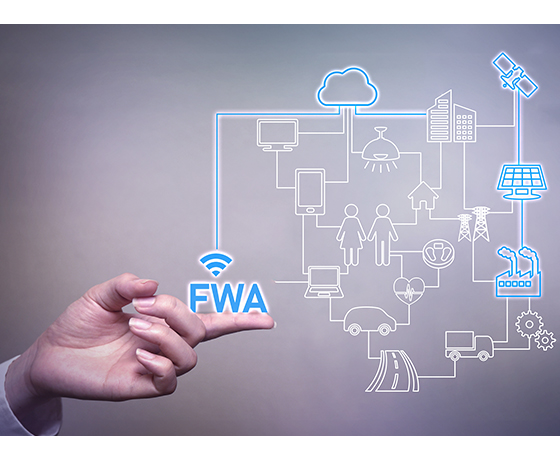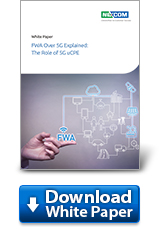FWA Over 5G Explained: The Role of 5G uCPE
The Trend
5G technology has been launched at an astounding pace and is continuously accelerating in its development, enhancing the functionality and performance of FWA (Fixed Wireless Access) application. Initially, FWA was a means to replace economically unviable wired networks for last-mile connectivity in rural and remote areas. Empowered by 5G and benefiting from increased bandwidth, complete connectivity, and rapid, flexible deployment, FWA has branched out further into various vertical markets. This recent advancement in 5G FWA technology has set up an arena for players from all over the world to compete for substantial business opportunities.

According to a June 2023 report by Ericsson, it is projected that by 2028, there will be over two hundred million 5G FWA users, constituting 17% of fixed network connections. The report also notes that there are already over 100 telecommunications companies worldwide offering 5G FWA application services. In the context of global efforts to bridge the digital divide, 5G FWA has become a crucial component in achieving nationwide broadband connectivity.
Currently, the primary application of 5G FWA is in public network scenarios where wireless transmission is used to reach the last mile. However, with the completion of the 3GPP Release 17 standardization, 5G applications are becoming more comprehensive. In addition to the fundamental functions of 5G, such as eMBB (Enhanced Mobile Broadband) in both FR1 and FR2 frequency ranges, URLLC (Ultra-Reliable Low Latency Communication), and mMTC (massive Machine Type Communication), advanced features like 5G network slicing, 5G TSN (Time-Sensitive Networking), 5G security, and NTN (non-terrestrial networks) enable 5G FWA technology to be used as 5G private network in various settings. These settings include smart factories, smart manufacturing, smart cities, and intelligent transportation (5G-V2X), etc.
The Challenge
The widespread adoption of 5G FWA across various sectors and situations underscores the importance of comprehending the unique requirements of each application in order to identify the most suitable equipment.
For service providers currently evaluating different options, it's advisable to take into account the following factors: the reliability of equipment for managing traffic, meeting critical low-latency demands, the necessity for mobility and outdoor wide-area connectivity, and a comprehensive, future-proof solution that caters to both present and future requirements.
For different field applications, 5G FWA can essentially be categorized into four attribute grades: Consumer Grade, Enterprise Grade, Industrial Grade, and Telecom Grade. Different grades of 5G FWA focus on different features and functions, allowing various usage scenarios to better showcase the advantages of 5G FWA. The following TABLE I illustrates the characteristics of different grades of 5G FWA.
TABLE I
5G FWA GRADES AND THEIR ATTRIBUTES
|
Attribute
Grade |
Bandwidth
|
Performance
|
Computing (AI)
|
Latency
|
Reliability
|
Slicing
|
Security
|
PoE
|
LAN
|
IP Code
|
|
Consumer
|
★ | ★★ | ★ | ★★★ | ★ | ★ | ★ | ★ | ★ | - |
|
Enterprise
|
★★ | ★★★ | ★★ ★★★ |
★★ ★ |
★★ ★★★ |
★★ | ★★ ★★★ |
★★ ★★★ |
★★ | - |
|
Industrial
|
★ ★★ ★★★ |
★★★ | ★★ ★★★ |
★ | ★★★ | ★★★ | ★★★ | ★★ ★★★ |
★ |
IP5x IP6x |
|
Telecom
|
★★ ★★★ |
★★★ | ★★ ★★★ |
★ ★★ |
★★★ | ★★★ | ★★★ | ★★ | ★ ★★ |
IP6x |
Requirements: Low ★/Middle ★★/High ★★★
Consumer Grade
- Deployment location: homes, suburban areas, islands
- Deployment type: indoor
- Purpose: 5G wireless transmission to replace wired transmission
- Benefits: increased bandwidth, fast deployment, reduced cost of laying wires
- Network environment: private and public
- Applications: MHN (mobile hotspot network), AP (access point)
Enterprise Grade
- Deployment location: office, bank, shopping mall, campus
- Deployment type: indoor
- Purpose: optimized user experiences and services
- Benefits: increased bandwidth, high performance, latency, and stability
- Network environment: private and public
- Applications: WIPS, SASE, MHN
Industrial Grade
- Deployment location: factory, smart cities, healthcare, sports event video streaming
- Deployment type: indoor, semi-outdoor and outdoor
- Purpose: optimized network bandwidth and performance, ultra-low latency, Quality of Service (QoS
- Benefits: stability and increased security
- Network environment: private
- Applications: Network Slicing, PoE Control, Firewall, IoT Gateway
Telecom Grade
- Deployment location: utility pole, smart traffic lights and control
- Deployment type: indoor, semi-outdoor and outdoor
- Purpose: consistent and stable network performance
- Benefits: stability and increased security
- Network environment: indoor, semi-outdoor and outdoor
- Applications: 5G Network Slicing, Network-in-a-box, 5G-V2X
Solution
Realizing the downsides of too many alternatives on the market and customers’ confusion, NEXCOM provides clarity by tailoring its products to cater to diverse application grades and settings for 5G FWA applications, suitable for deployment in both private and public networks. NEXCOM's range of 5G FWA appliances includes a selection of desktop units and 1U servers, categorized according to CPU performance and offering various wireless and wired connectivity options.
NEXCOM's desktop uCPEs are designed with both RISC and x86 architectures and are available either as a complete solution package with network OS or as white-box options for companies with own software research and development resources.
The entry-level appliance in the desktop 5G FWA lineup is the Arm-based uCPE - DTA 1376. This device is equipped with an NXP ® Layerscape® 4 cores processor that incorporates DPAA (data path acceleration architecture) to deliver a comprehensive set of networking accelerations, effectively integrating all facets of packet processing. DTA 1376 features seven 1GbE copper ports for Ethernet connectivity and offers optional support for 5G FR1 and Wi-Fi connectivity.
The mainstream appliance in the desktop 5G FWA lineup is Intel-based uCPE – DTA 1164W Series. Powered by Intel Atom® C3436L 4 core CPU and featuring a maximum of 16 GB of DDR4 ECC memory, M.2 SATA 2242 Key M 8GB SSD, it supports six 1GbE RJ45 copper ports, two 1Gb ports , Wi-Fi 6 and PoE, capable of providingup to 30W (802.11at) with a 72W 54V PoE power adaptor.
The Intel-based uCPE – DFA 1163 Series stands out as the highest-performing unit among the 5G FWA desktop uCPE lineup. It is equipped with an Intel Atom® C3558R/C3758R processor, boasting 4 or 8 cores respectively. This professional uCPE integrates a 10GbE SFP+ fiber LAN port for upstream data transmission to back-end Ethernet switches and onward to central servers. It also features copper ports with varying link speeds, including two 2.5GbE RJ45 ports and eight 1GbE Ethernet switch ports, enabling Ethernet services for IoT devices, such as VLAN and QoS. In terms of wireless connectivity, the DFA 1163M/Q SKUs stand out FWA product line with its support not only for Wi-Fi and 5G FR1 but also for 5G FR2 (mmWave).
The industrial grade DIN rail for 5G FWA applications - ISA 141 – is designed for deployments in relatively harsh environments. Powered by Intel’s quad-core Atom® processor, it is a compact, fanless appliance equipped with three 1GbE copper ports for network connectivity with one fiber combo port. The compact DIN rail design allows ISA 141 to be easily embedded in existing network infrastructure; while the out-of-band (OOB) management function enables IT personnel to maintain the devices remotely, guaranteeing consistent, high-performance operation. Its exceptional feature set includes dual Wi-Fi and dual 5G for concurrent connectivity and wireless load balancing, ensuring highly adaptable and advanced wireless connectivity.
The performance of each 5G FWA uCPE was tested through the Transmission Control Protocol (TCP) standard. The tests were performed at the NEXCOM office through Amari Callbox, 3GPP compliant eNB/gNB and EPC/5GC. The topology is shown in Figure 1.

Figure 1. 5G FR1 NSA/SA Test Topology
In 5G FR2 NSA mode, NEXCOM uCPE boxes underwent testing with a 3CC configuration, whereas 5G FR1 SA and NSA utilized the maximum Callbox capacity of 4CC. In this context, 3CC and 4CC denote the number of aggregated carriers employed for testing, dictated by test equipment configuration and network requirements. The outcomes are integral to understanding the uCPEs' performance under realistic and demanding conditions.
The test primarily emphasized download capabilities, allocating an average of 70% of Amari Callbox resources for this purpose. Meanwhile, approximately 20% were reserved for upstream tasks, and the remaining 10% were allocated for other functions. The achieved results for each 5G FWA uCPE were standardized and are presented in Mbps in TABLE II.
TABLE II
5G FWA PRODUCT PORTFOLIO, UPLINK AND DOWNLINK SPEED TEST RESULTS and GRADE MAPPING

In the 5G FR1 testing, the four DUTs utilize 5G modules sourced from diverse manufacturers. While the 5G FR2 NSA DUTs leverage two specific 5G modules: the X55 and X62. The X55 module provides compatibility with 3GPP Release 15, while the X62 module - an entry-level solution - supports 3GPP Release 16 with an exceptional cost-performance ratio. For a more in-depth understanding of each uCPE box's testing configuration and results, kindly request further information from NEXCOM representatives.
Overall tests prove that each of the tested appliances is ready for 5G FWA deployments in both SA (Stand Alone) and NSA (Non Stand Alone), i.e. public and private network environments.
Conclusion
5G FWA uCPE applications are boundless: from enabling real-time data processing for smart cities to ensuring mission-critical communications in industrial settings, and from revolutionizing healthcare with telemedicine solutions to providing seamless connectivity in remote areas. The impact of 5G FWA uCPE ensures reliable, low-latency, and high-bandwidth connections, and penetrates across diverse sectors, driving innovation and progress.
NEXCOM provides a diverse 5G FWA uCPE range tailored for various sectors and use cases. Each appliance comes with predefined features and expandable space, allowing customers to select additional options for a customized uCPE that suits their requirements. To make it simple, NEXCOM’s 5G FWA uCPE is also integrated with a light-weighted network OS for easy setting & control, enabling customers to concentrate on their applications without worrying about complex networking configurations.
- Related Links:
- Achieve Faster AI Insights with NEXCOM FTA 5190 and Xeon® 6 SoC
- NEXCOM Drives Edge AI, Dual 5G, and OT Security Innovation at CommunicAsia 2025
- Browse Other News:
- Urban PET Recycling Reinvented Sustainable Solutions Powered by NDiS B561
- AIEdge-X®80 Leaps Ahead: Power Up TOPS Performance with NVIDIA® Jetson™ Super Mode
- All White Papers News

